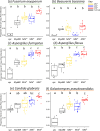A single amino acid polymorphism in natural Metchnikowin alleles of Drosophila results in systemic immunity and life history tradeoffs
- PMID: 38466751
- PMCID: PMC10957085
- DOI: 10.1371/journal.pgen.1011155
A single amino acid polymorphism in natural Metchnikowin alleles of Drosophila results in systemic immunity and life history tradeoffs
Abstract
Antimicrobial peptides (AMPs) are at the interface of interactions between hosts and microbes and are therefore expected to be rapidly evolving in a coevolutionary arms race with pathogens. In contrast, previous work demonstrated that insect AMPs tend to evolve more slowly than the genome average. Metchikowin (Mtk) is a Drosophila AMP that has a single amino acid residue that segregates as either proline (P) or arginine (R) in populations of four different species, some of which diverged more than 10 million years ago. These results suggest that there is a distinct functional importance to each allele. The most likely hypotheses are driven by two main questions: does each allele have a different efficacy against different specific pathogens (specificity hypothesis)? Or, is one allele a more potent antimicrobial, but with a host fitness cost (autoimmune hypothesis)? To assess their functional differences, we created D. melanogaster lines with the P allele, R allele, or Mtk null mutation using CRISPR/Cas9 genome editing and performed a series of life history and infection assays to assess them. In males, testing of systemic immune responses to a repertoire of bacteria and fungi demonstrated that the R allele performs as well or better than the P and null alleles with most infections. Females show some results that contrast with males, with Mtk alleles either not contributing to survival or with the P allele outperforming the R allele. In addition, measurements of life history traits demonstrate that the R allele is more costly in the absence of infection for both sexes. These results are consistent with both the specificity hypothesis (either allele can perform better against certain pathogens depending on context), and the autoimmune hypothesis (the R allele is generally the more potent antimicrobial in males, and carries a fitness cost). These results provide strong in vivo evidence that differential fitness with or without infection and sex-based functional differences in alleles may be adaptive mechanisms of maintaining immune gene polymorphisms in contrast with expectations of rapid evolution. Therefore, a complex interplay of forces including pathogen species and host sex may lead to balancing selection for immune genotypes. Strikingly, this selection may act on even a single amino acid polymorphism in an AMP.
Copyright: © 2024 Perlmutter et al. This is an open access article distributed under the terms of the Creative Commons Attribution License, which permits unrestricted use, distribution, and reproduction in any medium, provided the original author and source are credited.
Conflict of interest statement
The authors have declared that no competing interests exist.
Figures





Update of
-
A single amino acid polymorphism in natural Metchnikowin alleles of Drosophila results in systemic immunity and life history tradeoffs.bioRxiv [Preprint]. 2023 Jan 19:2023.01.16.524277. doi: 10.1101/2023.01.16.524277. bioRxiv. 2023. Update in: PLoS Genet. 2024 Mar 11;20(3):e1011155. doi: 10.1371/journal.pgen.1011155. PMID: 36712113 Free PMC article. Updated. Preprint.
References
-
- Libert S., Chao Y., Chu X. & Pletcher S. D. Trade-offs between longevity and pathogen resistance in Drosophila melanogaster are mediated by NFκB signaling. Aging Cell. 2006; 5: 533–543. - PubMed
-
- Lochmiller R. L. & Deerenberg C. Trade-offs in evolutionary immunology: just what is the cost of immunity? Oikos. 2000; 88: 87–98.
MeSH terms
Substances
Grants and funding
LinkOut - more resources
Full Text Sources
Other Literature Sources
Molecular Biology Databases

